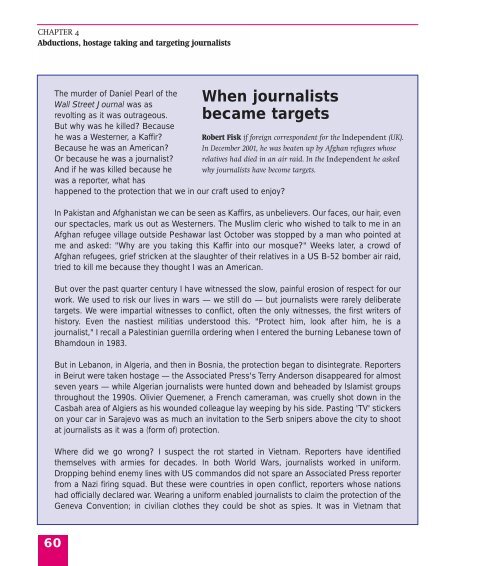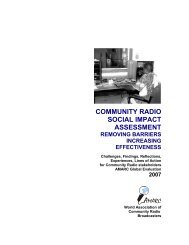Live News - A Survival Guide - International Federation of Journalists
Live News - A Survival Guide - International Federation of Journalists
Live News - A Survival Guide - International Federation of Journalists
- No tags were found...
Create successful ePaper yourself
Turn your PDF publications into a flip-book with our unique Google optimized e-Paper software.
CHAPTER 4Abductions, hostage taking and targeting journalistsWhen journalistsbecame targetsThe murder <strong>of</strong> Daniel Pearl <strong>of</strong> theWall Street Journal was asrevolting as it was outrageous.But why was he killed? Becausehe was a Westerner, a Kaffir?Because he was an American?Or because he was a journalist?And if he was killed because hewas a reporter, what hashappened to the protection that we in our craft used to enjoy?Robert Fisk if foreign correspondent for the Independent (UK).In December 2001, he was beaten up by Afghan refugees whoserelatives had died in an air raid. In the Independent he askedwhy journalists have become targets.In Pakistan and Afghanistan we can be seen as Kaffirs, as unbelievers. Our faces, our hair, evenour spectacles, mark us out as Westerners. The Muslim cleric who wished to talk to me in anAfghan refugee village outside Peshawar last October was stopped by a man who pointed atme and asked: "Why are you taking this Kaffir into our mosque?" Weeks later, a crowd <strong>of</strong>Afghan refugees, grief stricken at the slaughter <strong>of</strong> their relatives in a US B-52 bomber air raid,tried to kill me because they thought I was an American.But over the past quarter century I have witnessed the slow, painful erosion <strong>of</strong> respect for ourwork. We used to risk our lives in wars — we still do — but journalists were rarely deliberatetargets. We were impartial witnesses to conflict, <strong>of</strong>ten the only witnesses, the first writers <strong>of</strong>history. Even the nastiest militias understood this. "Protect him, look after him, he is ajournalist," I recall a Palestinian guerrilla ordering when I entered the burning Lebanese town <strong>of</strong>Bhamdoun in 1983.But in Lebanon, in Algeria, and then in Bosnia, the protection began to disintegrate. Reportersin Beirut were taken hostage — the Associated Press's Terry Anderson disappeared for almostseven years — while Algerian journalists were hunted down and beheaded by Islamist groupsthroughout the 1990s. Olivier Quemener, a French cameraman, was cruelly shot down in theCasbah area <strong>of</strong> Algiers as his wounded colleague lay weeping by his side. Pasting 'TV' stickerson your car in Sarajevo was as much an invitation to the Serb snipers above the city to shootat journalists as it was a (form <strong>of</strong>) protection.Where did we go wrong? I suspect the rot started in Vietnam. Reporters have identifiedthemselves with armies for decades. In both World Wars, journalists worked in uniform.Dropping behind enemy lines with US commandos did not spare an Associated Press reporterfrom a Nazi firing squad. But these were countries in open conflict, reporters whose nationshad <strong>of</strong>ficially declared war. Wearing a uniform enabled journalists to claim the protection <strong>of</strong> theGeneva Convention; in civilian clothes they could be shot as spies. It was in Vietnam that60
















